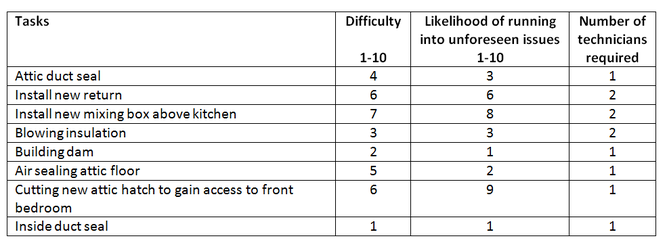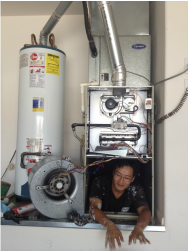Hire slow and fire fast. It’s a phrase that experienced managers and human resources professionals live by because many of us have learned the hard way that it only takes one bad hire to put your business into DEFCON Red Alert mode, which unfortunately tends to last weeks or even months after the event. Certainly, robust training programs, quality assurance, employee perks, good pay and an encouraging work environment all contribute to a company’s success, but it’s the human element, the employees that can ultimately make a company or department shine or shrivel. So why is it that our Human Resource departments are almost non-existent or thought of only in the context of payroll, workplace safety and those fun parties that we have every New Year? Of all our tasks we do in a week, how much time is actually devoted to improving our own hiring and interviewing skills? I would argue that the interview process is just-as or even more important than our training program and applies to all the Key Staff, not just the boss.
A right hire can bring your business or department to new heights, raising moral and productivity all while leaving a trail of positive reviews on their wake. A bad hire is an open door for theft, scathing customer reviews, and loads of anxiety and loss of sleep. Just like a successful home performance job or HVAC installation depends on prep work (of getting the correct sizes of wye’s, making sure the trucks are restocked, the guys have even water, batteries are charged and the team has reviewed the work order and photos) a successful interview and hiring process can be night and day in terms of that new hires’ productivity, contribution and long term development.
Once you have committed to developing your team’s interviewing and hiring chops, where should you start? In the home performance industry a great interview is less about asking strange, one off questions that take a psychiatrist to decipher, nor are they about simply chatting to see how well the candidate communicates (both things I have been guilty of). The start of a great interview begins by simply collecting information and probing into the candidates past.
A right hire can bring your business or department to new heights, raising moral and productivity all while leaving a trail of positive reviews on their wake. A bad hire is an open door for theft, scathing customer reviews, and loads of anxiety and loss of sleep. Just like a successful home performance job or HVAC installation depends on prep work (of getting the correct sizes of wye’s, making sure the trucks are restocked, the guys have even water, batteries are charged and the team has reviewed the work order and photos) a successful interview and hiring process can be night and day in terms of that new hires’ productivity, contribution and long term development.
Once you have committed to developing your team’s interviewing and hiring chops, where should you start? In the home performance industry a great interview is less about asking strange, one off questions that take a psychiatrist to decipher, nor are they about simply chatting to see how well the candidate communicates (both things I have been guilty of). The start of a great interview begins by simply collecting information and probing into the candidates past.

We all want employees looking to find an employer they can “grow old with”, who have “brought in millions of dollars in sales”, who have the “highest quality standards”, who have no problems working in attics and who etc etc etc. Talk is cheap and you should be weary of candidates that come with those lines because good interviewers don’t always make good employees. Do these two things to help prevent becoming a victim of thinking an employee who interviews well also will perform well with your company.
1. During the interview probe deep into their previous employment with questions revealing:
I was once interviewing a candidate for a crew position who praised the quality of his work and the high standard his company held them to only to find out it took a crew of 3 an entire week to complete a job that should be done in 1 day.
2. Always make sure to call their past employers to provide validation to their claims. Even if their previous employers won’t share personal information with you for legal reasons, asking if they are eligible for re-hire should steer you in the right direction. If you know someone at the company a personal call may be best.
Hiring managers should also be on alert for their own biases for those candidates who are not great interviewers but would be an ideal employee by making sure we are probing deep enough to get the candidate to share their job details for us to make an informed decision. When probing into their previous employment I am looking for the intangibles of their attitude toward their employer and their job, what the work environment was like, what time they started and finished, what exactly they did and who was their supervisor and what they did. More often than not the candidates that go into more details are the ones you want to keep, the ones that have nothing to hide.
During the resume review period there are some obvious natural fits you want to be on the lookout for, for example we know that people with backgrounds in HVAC, roofing, solar, and framing are good fits for a construction technician position. However, even if a candidate matches your ideal background for the position by letting them know you will need their supervisors phone numbers as part of the interview process for reference checks, you will weed out less than ideal candidates applying for your position. Candidates that did well or outperformed in their past jobs won’t have anything to hide whereas underperforming candidates won’t be as willing to share their previous experiences.
It’s a natural tendency to want to go with our gut on a new hire but the truth is if our gut was always right then we would never have to let someone go. Interviewers should be probing deeper into our candidates background to bring out specific examples of comparable skill sets. If you are hiring for a crew lead position rather than picking the candidate who has excellent presentation skills automatically, make sure you ask some tough questions to make sure they are comfortable disciplining the staff when necessary and they know when to separate being someone’s friend to being their manager. If you are hiring an energy auditor make sure you have your key performance metrics and examples of what your best energy auditors have done in the past to use as a benchmark. Just because a candidate has been doing energy audits with the City or a competitor for 10 years doesn’t mean that they will be able to adapt to your presentation and customer service requirements. They may be very strong technically but if they are not willing to learn your processes it won’t be a good fit.
When you bring a new staff member on, there tends to be a honeymoon period where the new hire seems to listen extra carefully, they follow directions to the letter, they are extra motivated to make a good first impression and they soak up their training like a sponge. This honeymoon time is critically important that the right habits are taught from Day 1 and I would also say that the honeymoon period even begins from the time a candidate sees your job posting for the first time, not just when their first day begins. Listing your KPI or Key Performance Indicators even in your job postings can set your expectations upfront. Discussing the major challenges of the position during the interview process gives you insight to how your candidate approaches and solves problems. Don’t wait until your candidate is already hired to find out they were an excellent apprentice but not prepared to be a journeyman.
Knowing what not to look for is also a valuable tool. Think of a time when an employee wasn’t performing to your standards. Now list out all the traits and specific things they did that were out of line. Just like your KPI’s will help keep your eye on excellence, that list will help you develop a nose for what to stay away from. If you notice underperforming staff tend to shy away from asking questions during the interview, it should be a red flag in your mind if an interviewee doesn’t have any good questions.
On the flip side you should also list the qualities of your best employees as well. These traits can be used in your job post and to form interview questions around to discover how new candidates rank in those categories.
For example if one of your desirable traits is a technician that has great time management ability, you can ask new candidates to rank the tasks below in order of importance and tell you why they chose what they did. Then compare their ranking to how you do your jobs. Candidates that show you new ideas on ways to do things are A candidates. Candidates that choose a similar order to what your team already does score a B. Candidates that are off in their reasoning or order ranking will get a C and so on.
- The work environment - what time did they start, who was on their team, what support did they have, did they have customer interactions.
- The operations they are used to- who got their materials, what did the work orders look like, who maintained the cars and equipment, how long did the jobs last, what tools they have, have them show you how to cut in a start collar.
- The performance metrics- what metrics were they measured against, what their close rate was, what kind of leads came in (are they the same quality as yours?)
I was once interviewing a candidate for a crew position who praised the quality of his work and the high standard his company held them to only to find out it took a crew of 3 an entire week to complete a job that should be done in 1 day.
2. Always make sure to call their past employers to provide validation to their claims. Even if their previous employers won’t share personal information with you for legal reasons, asking if they are eligible for re-hire should steer you in the right direction. If you know someone at the company a personal call may be best.
Hiring managers should also be on alert for their own biases for those candidates who are not great interviewers but would be an ideal employee by making sure we are probing deep enough to get the candidate to share their job details for us to make an informed decision. When probing into their previous employment I am looking for the intangibles of their attitude toward their employer and their job, what the work environment was like, what time they started and finished, what exactly they did and who was their supervisor and what they did. More often than not the candidates that go into more details are the ones you want to keep, the ones that have nothing to hide.
During the resume review period there are some obvious natural fits you want to be on the lookout for, for example we know that people with backgrounds in HVAC, roofing, solar, and framing are good fits for a construction technician position. However, even if a candidate matches your ideal background for the position by letting them know you will need their supervisors phone numbers as part of the interview process for reference checks, you will weed out less than ideal candidates applying for your position. Candidates that did well or outperformed in their past jobs won’t have anything to hide whereas underperforming candidates won’t be as willing to share their previous experiences.
It’s a natural tendency to want to go with our gut on a new hire but the truth is if our gut was always right then we would never have to let someone go. Interviewers should be probing deeper into our candidates background to bring out specific examples of comparable skill sets. If you are hiring for a crew lead position rather than picking the candidate who has excellent presentation skills automatically, make sure you ask some tough questions to make sure they are comfortable disciplining the staff when necessary and they know when to separate being someone’s friend to being their manager. If you are hiring an energy auditor make sure you have your key performance metrics and examples of what your best energy auditors have done in the past to use as a benchmark. Just because a candidate has been doing energy audits with the City or a competitor for 10 years doesn’t mean that they will be able to adapt to your presentation and customer service requirements. They may be very strong technically but if they are not willing to learn your processes it won’t be a good fit.
When you bring a new staff member on, there tends to be a honeymoon period where the new hire seems to listen extra carefully, they follow directions to the letter, they are extra motivated to make a good first impression and they soak up their training like a sponge. This honeymoon time is critically important that the right habits are taught from Day 1 and I would also say that the honeymoon period even begins from the time a candidate sees your job posting for the first time, not just when their first day begins. Listing your KPI or Key Performance Indicators even in your job postings can set your expectations upfront. Discussing the major challenges of the position during the interview process gives you insight to how your candidate approaches and solves problems. Don’t wait until your candidate is already hired to find out they were an excellent apprentice but not prepared to be a journeyman.
Knowing what not to look for is also a valuable tool. Think of a time when an employee wasn’t performing to your standards. Now list out all the traits and specific things they did that were out of line. Just like your KPI’s will help keep your eye on excellence, that list will help you develop a nose for what to stay away from. If you notice underperforming staff tend to shy away from asking questions during the interview, it should be a red flag in your mind if an interviewee doesn’t have any good questions.
On the flip side you should also list the qualities of your best employees as well. These traits can be used in your job post and to form interview questions around to discover how new candidates rank in those categories.
For example if one of your desirable traits is a technician that has great time management ability, you can ask new candidates to rank the tasks below in order of importance and tell you why they chose what they did. Then compare their ranking to how you do your jobs. Candidates that show you new ideas on ways to do things are A candidates. Candidates that choose a similar order to what your team already does score a B. Candidates that are off in their reasoning or order ranking will get a C and so on.
By basing your interview questions off existing traits you want more of or want to avoid you can find more well qualified candidates for your home performance business. Even when you are under pressure to a new hire, I’ve found it’s worth the temporary pain of being understaffed than to rush into a bad hire. While it’s impossible to find the perfect hire, hiring smarter will get you closer to surrounding your teams with all high performers and a winning culture.


 RSS Feed
RSS Feed